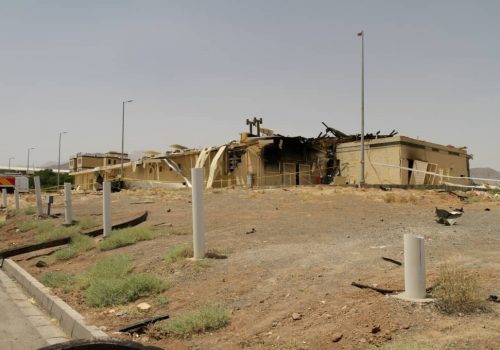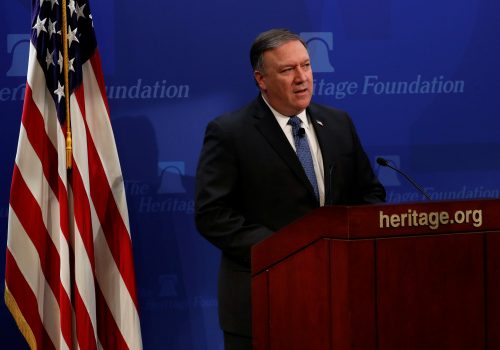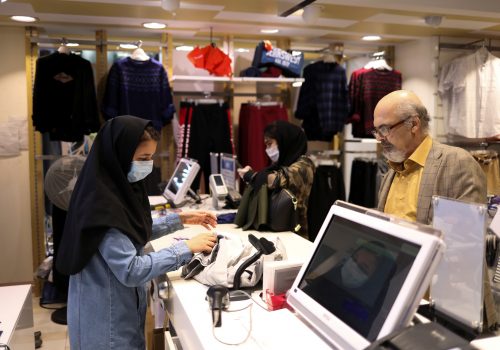What are the alternatives to the Iran nuclear deal?
The 2015 multilateral Iran nuclear agreement has largely lost its ability to contain Iran’s nuclear program. The United States exited the agreement in 2018 and re-imposed all US sanctions on Iran, thwarting efforts by the remaining parties to the accord—France, United Kingdom, Germany, Russia, and China—to persuade Iran to continue to adhere to the Joint Comprehensive Plan of Action (JCPOA) limitations on its nuclear activities. If a new agreement cannot be reconstituted in accordance with principles outlined by the Trump administration, the United States and regional powers might increasingly rely on direct action to constrain Iranian nuclear capabilities. Yet, military or other direct action against Iran’s facilities will likely have only fleeting effect, as compared to the benefits of a lasting Iran nuclear agreement.
The several explosions that have occurred in Iran since June, and particularly the July 2 explosion at Iran’s main uranium enrichment facility at Natanz, in central Iran, have raised the question whether the United States and its allies have begun to shift strategy against Iran and its nuclear program. Since mid-2019, as a response to the Trump administration’s 2018 withdrawal from the JCPOA and re-imposition of all sanctions, Iran has undertaken significant, although reversible, violations of the accord. The breaches have reduced Iran’s “breakout time”—the time thought needed to make enough fissile material for one nuclear weapon to about four months—from one year if there were full adherence to the JCPOA restrictions. The building at Natanz that suffered the explosion, and which commercial photographs show was severely damaged, is reported to be a site for the production of advanced centrifuges (devices used to enrich uranium). The JCPOA permits Tehran to research and develop, but not install, new centrifuges that can enrich many times faster than those that Iran is allowed to run. Were Tehran to begin installing and using the advanced centrifuges, Iran’s breakout time could shrink to the point where a nuclear-armed Iran appears imminent.
By imposing progressively stricter sanctions as part of a “maximum pressure” campaign, President Donald Trump has sought to compel Iran to agree to a revised deal that imposes even stricter limits on Iran’s nuclear program and places restrictions on other issues of US concern. Tehran has refused thus far to negotiate, insisting that the United States must first return to the JCPOA and lift all sanctions. As Iran’s adherence to the JCPOA declines, and the prospects for Tehran to negotiate a revised JCPOA appear remote, the United States and its regional partners—particularly Israel—might be considering alternatives to mitigate the potential nuclear threat from Iran.
There are indications that the United States and/or Israel might have already begun to adjust strategy on Iran’s nuclear program from reliance on the JCPOA to undertaking direct action to try to destroy Iran’s nuclear infrastructure. Although there is no direct evidence that the July 2 Natanz explosion was caused by a deliberate attack, a report in the Washington Post, quoting a “Middle East security official,” said that an explosive device was planted at the facility to “send a signal” to Tehran. Israel’s Defense Minister Benny Gantz said his country was not “necessarily” behind every explosion in Iran, a formulation that suggested to some the explosion was an Israeli operation. Israel, if it was behind the attack, might have used agents inside Iran to strike the facility, a tactic that Israel has previously demonstrated. In 2018, Israeli Mossad agents infiltrated a warehouse in Tehran and retrieved documents about Iran’s earlier efforts to develop a nuclear explosive device. Israel’s Prime Minister Benjamin Netanyahu provided the documents to the International Atomic Energy Agency (IAEA) for further follow-up work in Iran and asserted that the discovery backs up his assertion that Tehran was continuing to research a nuclear explosive device, despite its JCPOA and Nuclear Non-Proliferation Treaty (NPT) commitments. In 2010, the United States and Israel jointly developed and employed the “Stuxnet” computer worm to destroy 80 percent of the centrifuges that Iran was then operating at Natanz.
The putative Israeli action against Natanz revives the longstanding debate over the optimum strategy to prevent Iran from eventually developing a nuclear weapons capability—a debate that preceded the US decision to negotiate the JCPOA with Iran. Although some Israeli security experts estimated that the destruction of the Natanz facility might set back Iran’s nuclear program by as much as two years, most proliferation experts assess any damage as transitory and marginal, at best. The damage caused by the Stuxnet cyberattack set back Iran briefly, and likely contributed to Tehran’s decision to develop countervailing cyber-attack capabilities.
Iran’s apparent ability to reconstitute damage to its facilities and equipment from any attack was a key consideration in the Barack Obama administration’s conclusion that a diplomatic accord with Tehran was the only way to assure US objectives over the longer term. The Obama administration assessed that even a significant US bombing campaign would only set Iran’s nuclear program back by a maximum of a few years. The difficulty of achieving success through military action was a factor in Israel’s decisions during 2010-2012 to refrain from a major airstrike on Iran’s nuclear infrastructure.
The Trump administration faces similar questions in 2020. The maximum pressure campaign has damaged Iran economically but not brought Tehran to the bargaining table. Trump faces a choice between accommodating some of Iran’s preconditions for talks or adding direct military or covert action against Iran to the US policy formula. The explosion at Natanz might demonstrate that the Trump administration—in this case acting through a like-minded partner, Israel—might have made that choice in favor of direct action. If so, the assessment of experts that action against Iran’s facilities will have only transient effect—as compared to the effects of diplomatic agreement with Iran—will be put to the test.
Dr. Kenneth Katzman is an Iran expert at the Congressional Research Service. This article is written in a personal capacity and does not reflect the views of the Congressional Research Service or the Library of Congress.
Image: Iran's top nuclear negotiator Abbas Araqchi and EEAS Secretary General Helga Schmid attend a meeting of the JCPOA Joint Commission in Vienna, Austria December 6, 2019. REUTERS/Francois Murphy


